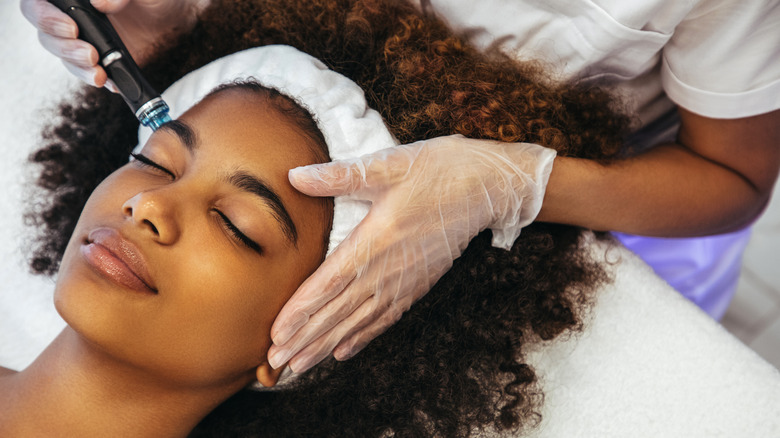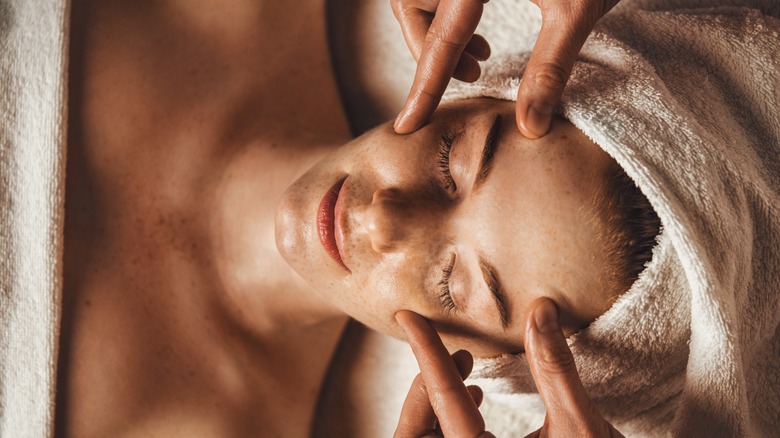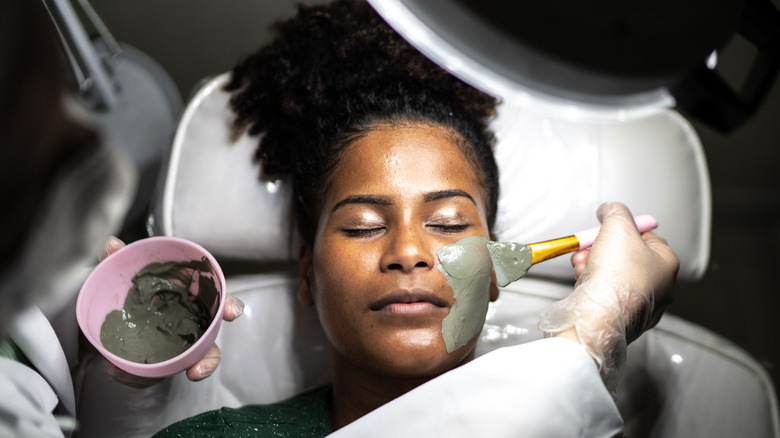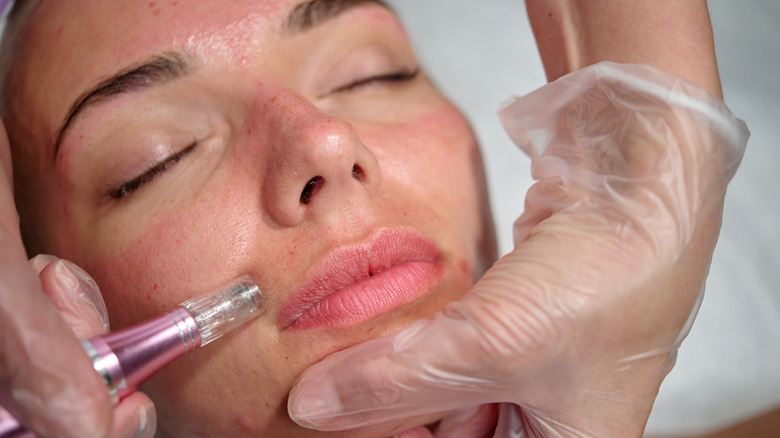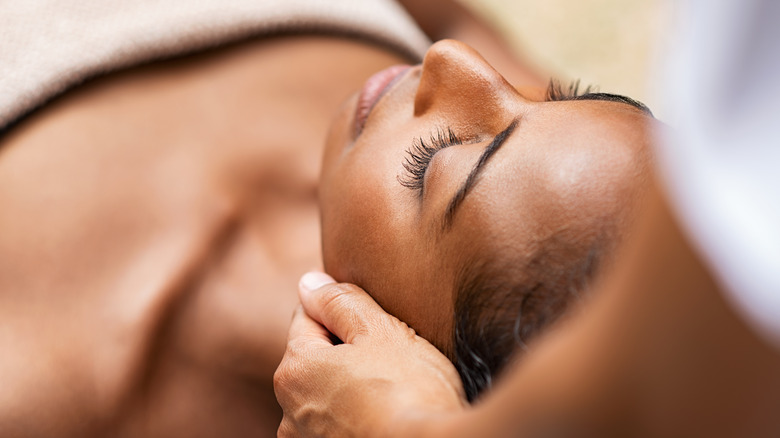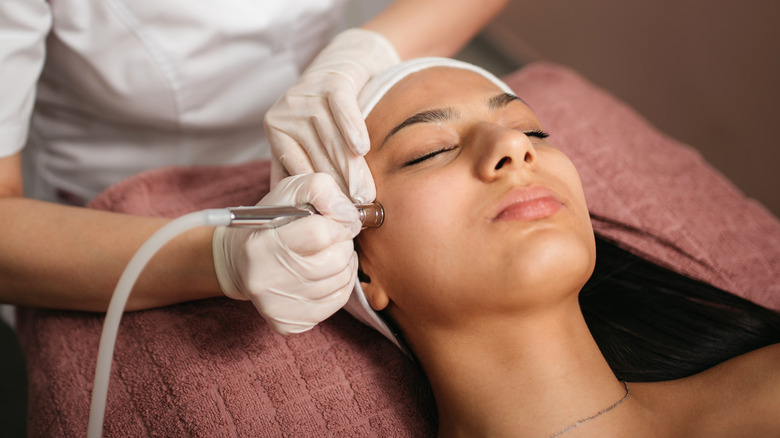The Go-To Treatments To Try If You Have Dehydrated Skin
There's nothing worse than dehydrated skin. Often confused with dry skin, dehydrated skin goes beyond just being dry and moves into the territory of not being able to maintain appropriate water levels to stay moisturized from the inside out.
"As we get older, our bodies don't make the same kinds of lipids and they don't function as well," board-certified dermatologist Dr. Amy Newburger told Today. "So ... the skin doesn't have as intact a barrier because that outer layer of dead skin is what keeps us watertight... If you're waiting for your skin to show symptoms or if you're waiting and notice that your skin is feeling tight or painful or irritated or itchy, that means we've already lost quite a bit of hydration and it's time to really try to catch up."
Although there are plenty of products on the market that help with hydration, sometimes the best route to go is in-office treatments, if you want to get your most hydrated skin ever. From facials to chemical peels, and similar non-invasive options, no matter your hydration needs, there's a treatment out there for you.
Glo2Facial
Although the Glo2Facial can be beneficial for many different skin-related issues and can be used on different skin types, it really shows its capabilities when it comes to hydrating the skin. "Glo2Facial is based on a three-step process of OxfoliationTM, LUX (lite ultrasound experience), and detoxification, delivering immediate and long-lasting results," senior VP of Marketing for Geneo (the company that makes it) Rosemarie Holcomb told TZR.
By using both blue spirulina and hyaluronic acid (a must-have skincare ingredient for many skin types), the treatment strengthens the skin's barrier and improves its ability to retain moisture. It also creates a CO2-rich environment through the use of Geneo OxyPods, which contain red algae, charcoal, and vitamin C that encourage enhanced hydration. Although some people are able to see the results after one round, monthly treatments for up to six months will really make a difference in your hydration levels. Depending on where you live, a Glo2Facial can cost anywhere from $200 to $500.
Chemical peels
When it comes to chemical peels, there are three depth options: light, medium, and deep. Each one works by removing the layer of dead skin to encourage new cell growth and reveal a more youthful and hydrated complexion. The intensity of the peel determines the downtime, the results, and the price.
"When skin grows back after a chemical peel, it triggers the production of collagen and elastin so they can diminish signs of ageing including wrinkles, fine lines, ageing spots, uneven skin tone, roughness, and dryness," aesthetic nurse Sarah Whitehead told Professional Beauty. "A superficial peel will remove the outer layer of the epidermis, medium-depth peels remove skin cells from the epidermis and the mid-dermis level, and deep peels are more aggressive, penetrating to the reticular dermis."
According to Cleveland Clinic, the light peel, also known as a lunchtime peel, can have you recovered in anywhere from a few hours to a few days, and can be done every few weeks until you reach optimal hydration. The medium peel takes about a week to recover from and can be performed six to 12 months apart. The deep peel, on the other hand, is so intense that it's not only a one-time procedure, but takes several weeks to bounce back from and even includes pre-chemical peel treatments. The American Society of Plastic Surgeons reports that the average cost of a chemical peel is $1489, but what kind you get and where you live affects the exact price.
Aquagold
In recent years, microneedling has become a common treatment that people with skin-related issues have sought out. According to Cleveland Clinic, it's great for diminishing the appearance of everything from wrinkles to scars. It's also great for hydrating skin via collagen production, encouraged through the minuscule holes that are pricked into the outer layer of the epidermis. Aquagold takes traditional microneedling up several notches and by injecting hydrating components.
"This microneedling treatment uses tiny gold needles to infuse a customized cocktail of ingredients into the skin," board-certified physician assistant and licensed skincare expert Merry Thornton, PA-C told TZR. "With these two particular items, you can quickly draw water back into the skin and even shrink pores to brighten tone and improve texture."
Aquagold has really minimal downtime — not more than an hour — and takes less than an hour to be performed. Although it's pretty pricey, ranging between $700 and $1200, the effects can last up to six months, especially if you stick to the recommended amount of sessions.
Hydrafacial
True to its name, Hydrafacial is a facial that hydrates. And it apparently does so like no other. According to Hydrafacial's official website, 3.5 million of these treatments are performed every year and the results are so loved that 92% of people would ditch their current esthetician if they stopped offering them as an option.
"The Hydrafacial is a multistep facial treatment typically performed with a proprietary machine (Hydrafacial MD) manufactured by Edge Systems," chief medical officer for the Schweiger Dermatology Group Glen Crawford, MD told Everyday Health. "In one session, aestheticians can use the Hydrafacial [device] to cleanse, exfoliate, extract, and deliver a variety of rejuvenating serums." Unlike other options, there's no downtime with a Hydrafacial and it can be completed in 30 minutes with immediate results. However, to get the most out of this treatment, it's best to have them done regularly, ideally every four to six weeks. The average price for this procedure is $225.
DiamondGlow
Like Glo2Facial, DiamondGlow is also a three-in-one treatment that results in maximum hydration. As a dermal infusion, DiamondGlow works like a microdermabrasion which can do a lot for your skin, on top of hydrating it. "The treatment uses a diamond tip to exfoliate off the top layers of the epidermis, and uses a light, vacuum-like suction to cleanse within the pores, all while pushing treatment serums deeper into the skin than they're normally able to go," board-certified plastic surgeon Dr. Lawrence Iteld, MD told Byrdie.
With DiamondGlow, the results are instant, there's no downtime, and you don't have to wait to see how fantastic your skin looks. It also only takes 10 to 15 minutes and, despite involving actual diamonds, is fairly affordable, running somewhere between $100 and $300 for each session.
As amazing as all these treatments sound, you don't want to roll into your dermatologist's office demanding to give each one a try. While you're likely to prefer one treatment to another and that requires trying more than one of them, you still want to take your dermatologist's advice on which option is best for your skin and the amount of hydration it needs to get back on track.
